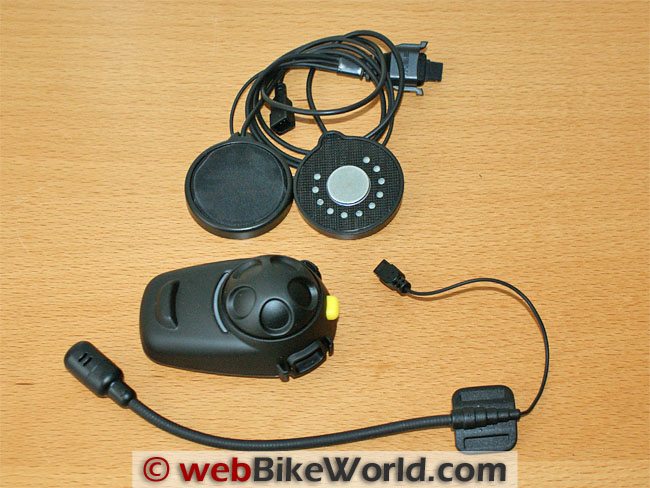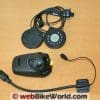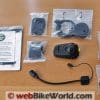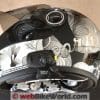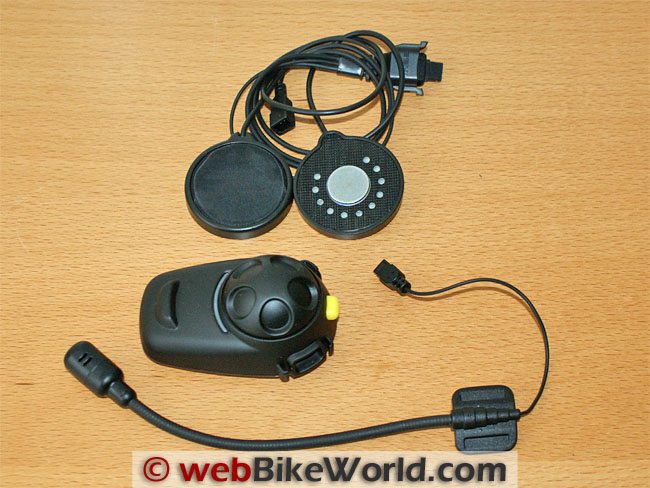Sena keeps putting the good stuff together and getting it out to the market.
The second iteration of the downsized but very capable SMH5 intercom, now endowed with an integrated stereo FM tuner, is an example.
It’s also one of the reasons Sena was chosen as thewebBikeWorld Bluetooth Technology Provider of the Year in 2012.
Not to take anything away from all the other great Sena intercoms, but the new SMH5-FM incorporates more of what we see in the higher-priced models.
Although it’s still not a feature-for- feature peer of its bigger sibling, the very popular Sena SMH10B (review), the SMH5-FM is probably better than the original SMH10 and it beats many of its contemporaries.
Given other enhancements to the SMH5 that include greatly increased intercom range and multi-party pairing in addition to the stereo FM radio feature, the newest SMH5 variant is probably an even better deal than the original and it is well worth the extra $30.00 USD per unit.
I just hope Sena is prepared to meet the demand!
Background
This review can also be considered either as an addendum to the original webBikeWorld Sena SMH5 review or as a Part 3.
The SMH5-FM is based on the original SMH5, but a “Quick Look” was in order to let our loyal readers know that the latest version of this extremely popular and highly rated system is now equipped with a stereo FM radio capability.
Both Rick and “Burn” were very impressed with the downsized but fully capable original SMH5 intercom and my longer-term Part 2 evaluation continued that very positive experience.
But after finishing the Part 2, the SMH5 systems were packaged up and reluctantly sent back to the Editor for other uses. While I don’t have any real shortage of Bluetooth systems on hand to use, the SMH5 units were missed.
In the meantime, Sena continues to expand their market space with new models, one such being the Sena SMH10R Low Profile model, also currently undergoing a wBW evaluation.
Sena also works hard at enhancing their market position through design standardization and firmware updates — all positive, dynamic and healthy moves that we as consumes benefit from.
For now, the SMH5-FM and the new SPH10H-FM half-helmet intercoms remain unique in the Sena lineup, both with an FM tuner included. The original Sena SP10H half-helmet system has also been redesigned and simplified.
It now uses an upgraded SMH5 module mounted on the left side piece rather than the balanced left and right moldings used on the original version.
It has also acquired the “FM” designation; stay tuned for an upcoming wBW evaluation on both versions.
But back to the present…the SMH5-FM model was actually the first one out of the Sena gate with the FM tuner feature announced in a press release of 28 November 2012.
But this wasn’t the only change made — there have been other enhancements as well that unfortunately didn’t get played up to the degree the FM radio did; time to rectify that.
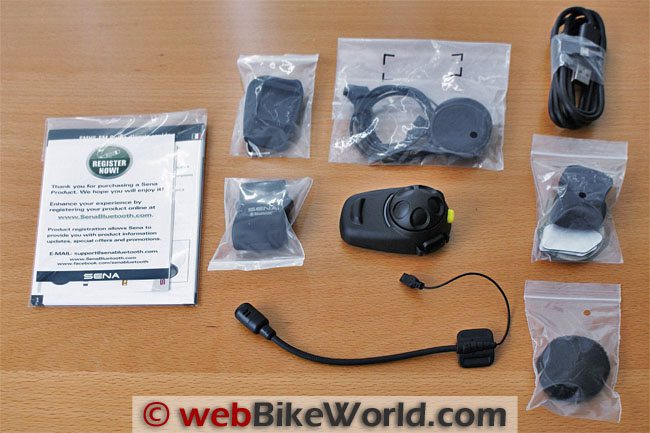
Change Is Good
Like the original great deal version, the SMH5-FM is a basic package, with fewer included accessories than the more expensive SMH10.
Note that when ordering your SMH5-FM, you’ll need either choose between the open-face version (SMH5-FM-01) with the boom microphone or the full-face helmet version (SMH5-FM-02) kit with the wired microphone.
It depends on the type of helmet that will be used for the installation (although the boom mic versions can be used in many full-face helmets).
While I still feel Sena should include both microphone options in the basic kit, the microphones, the large speaker headset and other goodies are available as reasonably-priced accessories.
The SMH5-FM intercom module is physically identical to the original, including the standard lightweight headset. The SMH5-FM and SMH5 (review) are “water resistant for use in inclement weather”, according to Sena.
Both systems use Bluetooth 3.0; but from this point on the SMH5-FM starts to (literally) distance itself from the original, as I will describe in the following sections.
Sena SMH5-FM Intercom Performance
This feature has really been tweaked, with a stated range increase from 400 meters to 700 meters (430 to 760 yards) compared to the original SMH5.
This a significant increase, reflective of other standardization and performance changes being made by Sena to their systems.
SMH5-FM Multi-Party Pairing
The original SMH5 was limited to pairing with one other SMH5 or another member of the Sena Bluetooth family but no more.
The new variant can now be paired with two, three or four other SMH5-FM or SMH/SPH10 models for intercom use. This provides more flexibility and more standardization, without any additional cost.
The Sena SMH5-FM Stereo Tuner
Other Bluetooth helmet systems have offered an FM tuner for some time, although some implementations were/are less than user friendly or with limited performance.
The newer generation of integrated tuners are far better — and that includes the one implemented in the SMH5-FM.
With station-to-station or band scanning, 10 station presets and RDS tuning, Sena has added a very cost-effective and attractive feature and like other options it can be used, or not.
I have come to appreciate the capability, especially when travelling as it is an expedient and cost-effective means to keep track of local weather conditions and traffic in FM coverage areas.
For anyone who has used an FM tuner feature on other headsets, the Sena implementation will seem familiar and if not, then time spent in “discovery” mode pays dividends in getting the most out of this feature.
Pressing the “Phone” button for two seconds results in a double-beep tone followed by the built-in spoken voice guide saying “FM on”.
Another two-second push will turn the radio off, confirmed by “The Voice” saying “FM off”. The last active frequency or station will be remembered for the next radio session.
The Scan and Save feature used the Phone button to activate and control an Up or Down frequency search through the available FM band (varies globally) with the tuner stopping on active stations, with the Phone button used for control.
The Seek and Save function uses the Sena Jog Dial (the big round dial) to initiate and control jumps from Station to Station; push in on the Jog Dial and rotate it clockwise (search up) and counter-clockwise (search-down).
Once detected and tuned by either Scan function, a station can be saved off to any of the ten stored presets using the Jog Dial.
These Preset Stations are stored and available for recall at any time even after the system is turned off — just tap the Phone button once while the FM radio feature is activated to jump up to the next preset.
Temporary tuning or presets are also available by tapping the Phone button three times to initiate a scan. Up to ten stations can be held in temporary memory, but once the system is turned off this data is gone.
And don’t forget, all of the radio settings can be accessed by running the Sena application as well on a PC or Mac…
The Radio Data System
The Alternative Frequencies or RDS AF feature allows the integrated receiver to find and re-tune to different frequencies used by the current active station in order to maintain an optimal signal and thus optimal audio.
The Sena default for this option is Off. To enable the feature, press and hold the Jog Dial for two seconds to enter the RDS AF setting mode, then tap the Phone button to enable the mode.
Specific information and instructions for FM radio operations are found in Section 10.8 of the SMH5-FM User Guide.
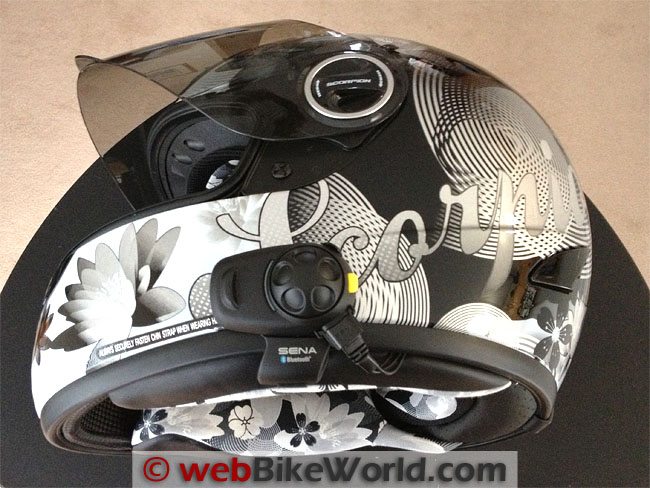
Firmware Updates
Like all new Sena intercoms with a USB port, the SMH5-FM is upgradeable using the Sena Bluetooth Device Manager (current v1.4) that is the one-stop device upgrade and configuration application for MS Windows or Mac v1.8 operating systems.
Selecting the respective intercom in the Device Manager application (in this case the SMH5-FM tab) and working through the firmware download, the ROM flashing and validation steps to take advantage of the bug fixes, tweaks and enhancements provided by Sena only takes a couple of minutes.
The initial firmware release provided with the SMH5-FM intercoms we received was v1.2 (7 November 2012).
Since then, Sena has released v1.2.1 (9 January 2013) and v1.2.2 (23 April 2013), with minor bug fixes for the intercom and FM radio and HFP connection and improving compatibility with GPS devices.
With the FM tuner implementation, a new tab has been added when running the SMH5-FM updated and configuration menu under the Bluetooth Device Manager application. It looks grayed out, but it will activate when it is clicked, allowing management of the FM feature via software.

Ride Report With Observations
With four different Sena intercom types on hand (three undergoing current evaluation), the opportunity to see how well the different systems work together was a given.
Paralleling the cross-platform compatibility model long used by Cardo Systems in their Scala Rider series, the Sena family members all work with each other.
Although like the Cardo systems, there may be specific or legacy limitations; something the new SMH5-FM to a large degree, has now shed.
Sena SMH5-FM Intercom Range
on fairly open terrain with modest elevation changes the SMH5-FM models were going strong at 700 meters and it wasn’t until around the 850 meter mark that the link got noisier and the audio scratchy, then dropped, with seamless restoration once the distance dropped back to around the 800 meter mark.
Riding up, down and around the longer curves and elevation changes of the I-64 and then the tighter curves of the US250 and US33 of western Virginia, a reliable intercom link could be maintained at 500 to 600 meters.
That is, appreciating that there might be one or two curves or some natural barriers between the riders at that time.
Being able to use the longer range SMH5-FM intercom capability with the even longer-ranged SMH10 models is a very impressive performance improvement and a great equalizer for multi-rider activities.
Multi-Party Connectivity
Another improvement with the SMH5-FM is being able to move beyond the two-user limitation and configure the SMH5-FM for three and four user use as well.
Sena Jog Dial Differences
After using the larger Jog Dial on the SMH10 intercoms and then moving down to the smaller Jog Dial on the SMH5 models — especially with medium- to heavy-weight gloves — can require a bit of an adjustment.
Particularly when trying to finesse the push and rotate sequences, which are now even more extensive with the added FM radio controls and tuning options described earlier.
But this is really a very subjective observation and in reality the Jog Dial, no matter its size, is leaps and bounds ahead of having to use multiple buttons — trust me.
Voice Menu – Spoken Status Announcements
With the addition of the FM Radio, the built-in Voice Menu or spoken status announcements capability has expanded its repertoire appropriately.
Thus, a few minutes spent sitting to just play with the system, including the FM functions, typically results in less frustration while riding — which isn’t the best time for trying to figure out a specific feature anyway.
FM Radio Performance
Having now used (almost) every FM tuner equipped Bluetooth system on the market, the progress made in moving from mono audio to stereo for the radio, and now reliable tuning and stable signal tracking brings a smile to my face.
FM radio performance is typically so good now that I often don’t worry about using other audio sources (e.g., MP3 players).
And outside of finessing the smaller Jog Dial to provide the desired or required input, the Sena implementation is very good…but, I’ll admit, not as good as the FM radio on the new Vertix Raptor-i (review).
The RDS:AF feature is another option that needs to be played with to understand and utilize fully. In some FM broadcast environments, using it can be a positive experience, while in others…not so much. But in general, I find that it does provide for better acquisition and signal tracking, typically resulting in better audio from the tuned station.
Sena SMH5-FM Battery Performance
With sustained intercom use mixed with listening to the FM radio and some extended periods of audio streaming, one charge is good for a full day of riding and sometimes an hour or two more. So it seems the “7 hour talk time” (no other use identified) is a valid expectation.
After a full day of use, recharging typically takes an hour or so, which could indicate the battery is still around the 50 percent mark, but this is a subjective assessment.
Sena said that the battery should last several years. In their tests, the battery can be charged up to 500 times and the battery life would be reduced by approximately 20% from new.
After 1,000 charge cycles, the battery life would be reduced by about 40%.
Optimally, the owner should keep the battery charged and try to avoid letting it run down to zero, which puts a strain on the battery when it’s recharged. Also, recharge the battery occasionally if the intercom is in storage for extended periods.
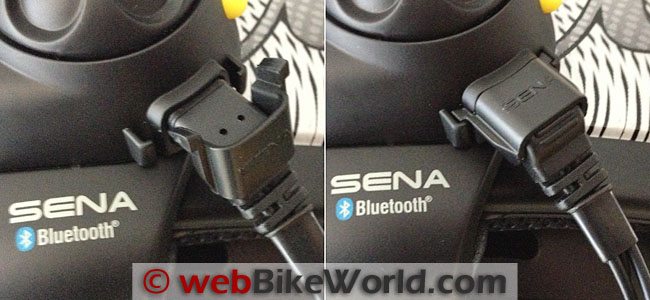


Conclusion
At the risk of sounding like a broken record or a loop recording, the original Sena SMH5 is a very competent Bluetooth helmet system for a great price, in single or dual set packaging. But the new SMH5-FM model is even better.
Excellent enhancements to the base intercom system and the addition of the FM tuner hasn’t grown the physical size of the original SMH5 either.
So for those motorcycle riders who want the FM radio feature or for those who actually utilize it (like I do for many reasons, including travel safety), the Sena SMH5-FM intercom will be a welcome addition to the market, despite its modest $30.00 USD increase from the base price.
Also: Sena SMH5 Review
|
wBW Review: Sena SMH5 Intercom
|
|
|---|---|
| Manufacturer: Sena Technologies | List Price: $299.00 (Dual Pack) or $159.00 each. Available From: ▪ Sena SMH5 at RevZilla ▪ Sena SMH5 at the wBW Amazon.com Store |
| Colors: Matte Black. | Made In: Korea |
| Review Date: May 2013. | |
Note: Item provided by a retailer, distributor or manufacturer with these Terms and Conditions.
Owner Comments and Feedback
See details on submitting comments.
From “J.C.” (October 2013): “This is what Bluetooth should be like, unbelievably great everything.
I have the Scala Rider Q2 Pro (review) on a Scorpion EXO-900 (review) which I always had a problem with the volume not being loud enough always pushing the high volume button. Until I read your review on the Sena SMH-FM tuner intercom.
Bought one and put it in the Scorpion immediately, installation was very simple.
And I like the boom not attached to the bottom of the mounting mechanism, which the Cardo’s boom can get pinched after a while on a modular helmet.
Used it all weekend, the volume was awesome.
Can’t wait for their new product the Sena 20S will buy for my new Shoei Neotec Borealis.
The price of the Sena was almost half the price of New Cardo, Guess what all my rider friends are going to upgrade to for a lower price. Thank you webBikeWorld and Sena.”
From “T.G.” (June 2013): “Thanks for the suggestion for the SMH-5. For those looking for just an intercom I think that the sound volume and ease of use over shadows the other choices we have tried, UClear HBC200 (review) and Cardo Scala Rider G9 (review).
We had some hiccups and after a very easy install. I will note the G9 speaker wires were a little short to route nicely in my Shoei Multitec (review).
We read about buying the upgraded speakers from the Sena SMH10 (review) and I have to say that they were too loud and we had to turn them down. I did a factory reset after a few glitches in the beginning and that seemed to fix it all.
All controls are easy to figure out and there are only 2 buttons to worry about. Very solid mounting bracket included. The jog dial is very organic and easy to use and figure out.
Want to talk to your buddy. Tap your ear. Done talking tap again. Buddy want to call you. Tap his ear. It’s so freaking easy.
We don’t listen to music when we ride nor make phone calls so for us the Sena hits all the right bullet points and is also one of the least expensive of the group.”
Update from “T.G.” (April 2014): “I can confirm that the new (Sena) update firmware fixes the static issues. Also supposed to work with non-Sena communicators.”
Update From “T.G.” (July 2013): “Now having lived 3 weeks and about 1,000 miles, I can continue to praise the SMH-5. I have used it now in some blinding rain squalls that have been very common here in Florida the last few weeks.
They are very water resistant if not downright water proof. I’m impressed.
I have experimented with the music functions and have taken a few phone calls off the bike. I have to stress that talking on the phone when riding a motorcycle is something that is extremely dangerous as you really need to focus on your riding.
Phone calls were seamless. Tap your ear and talk. Music stops and phone cuts in. Finished talking. Tap your large ear button. Phone hangs up. Music starts up. Want to talk to your buddy. Hit your big jog dial. It’s quick to switch.
Range is about 0.7 mile straight line. If you loose your buddy it will automatically relink. We started one ride at sunup and got back about 12 hours later and still had 50% power; you count the flashes when you turn on the unit
For the price the SMH-5 is the clear winner. I have to take to task UClear and the “Booms suck” campaign.
With my modular helmet the boom is a non issue. If I need more range I guess the next choice would be the Sena SMH-10 (review). Thanks so much for your website and reviews.”


